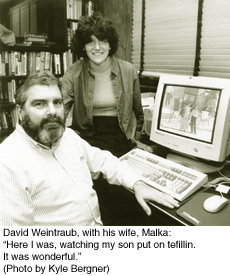|
|
|
|
|
|
|
|
|
|
|
|
|
|
|
||
|
|
|
||
|
|
On a warm Sunday morning two weeks ago, Yonah Weintraub put on tefillin for the first time, one month before his bar mitzvah, at the Kotel, the Western Wall in Jerusalem. Although 7,000 miles away, his father, David Weintraub, caught every moment of the rite of passage in his Upper Park Heights home office, with a click of his computer mouse and a 30-second delay. "I felt great," said Mr. Weintraub, a physicist. "Of course, I would much rather have been there. But here I was, watching my son put on tefillin. It was wonderful." Mr. Weintraub, who is divorced from Yonah's mother, Phyllis Weintraub, a former Baltimorean who immigrated to Gaza in 1993, will attend his son's bar mitzvah Nov. 27 in Israel with his wife, Malka. Although it is customary among many Orthodox boys to put on tefillin one month before their bar mitzvah, Mr. Weintraub was unable to fly over earlier and accompany his son Oct. 24 to the Wall. Instead, Mr. Weintraub participated via KotelKam.com, a Virtual Jerusalem computer Web site with a camera stationed at the Kotel Quarters Mini-Hotel. With the click of a mouse, participants who register at no cost on the Kotel Kam Web site can immediately angle the camera, zoom in, lighten or darken the image, and even capture the shot on their computer hard drive through Perpetual Robotics iCam. Phyllis Weintraub first found out about Kotel Kam from a friend whose brother was able to watch her son's bar mitzvah at the Western Wall last August from his California home. "I said, 'What a great idea,' " recalled Ms. Weintraub, from her home in Gush Katif. "Then I told David that he could watch Yonah putting on tefillin on this Internet connection." Ms. Weintraub and Yonah arrived at the Kotel about 7 a.m. Sunday, accompanied by Rabbi Yirmiyohu Kaganoff, a Jerusalem resident and former spiritual leader of Darchei Tzedek Synagogue in Pikesville. "I asked him to come and help him out," said Ms. Weintraub, an entomologist for Israel's Agriculture Research Organization near Beersheba. After midnight Saturday in Baltimore — Israel was six hours ahead before daylight-saving time — Mr. Weintraub searched for Yonah on his computer. "I saw the Kotel area gradually filling up and was wondering where they were," said Mr. Weintraub, a member of the Beth Abraham and Bais Lubavitch synagogues. Although Mrs. Weintraub was scheduled to call him on her cell phone when they arrived, she could not reach him. "But as I was watching, I could see Phyllis from the back and could see her talking to Yonah and a man who might be Rabbi Kaganoff," recalled Mr. Weintraub. "So I called her on her cell phone. The first thing I said was, 'Could you move about two meters to your right?' She laughed and moved. So I got to watch him putting on tefillin. It was gevaltdik [great]." He also conversed with Yonah over the cell phone. "Before, I felt bad that he wasn't going to see it all, until my mother told me about this Internet connection," said Yonah, who visits Baltimore every Passover and summer vacation. "It was pretty amazing, but it felt weird that he was speaking to me and he could see me, but I couldn't see him." By using his software, Mr. Weintraub captured 11 photographs with each click of the mouse. But when Yonah joined a minyan for Shacharit, or morning prayers, he walked out of the camera's view. Unable to see him, Mr. Weintraub told Yonah's mother that he was going to sleep. But he ended up talking to his wife while keeping one eye on the monitor. When prayers ended about 40 minutes later, Mr. Weintraub saw Yonah looking straight ahead as Ms. Weintraub pointed out the site of the Kotel Kam camera. As Mr. Weintraub prepares to leave for Israel Nov. 17 — with his wife, his father, Charles Weintraub, 90, of Pittsburgh, and his older sister, Claire Weintraub, of Montreal — he will send ahead the electronic images. "But it will be even better," said Yonah, "when he sees me in person." |
|
Copyright ©2000 the Baltimore Jewish Times |

